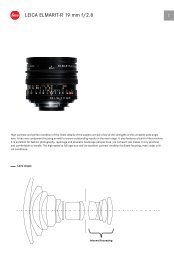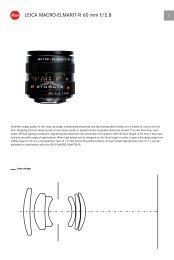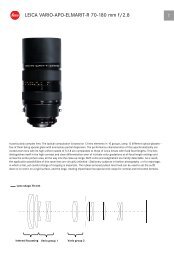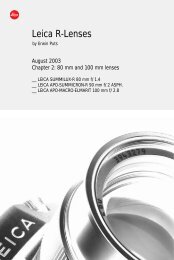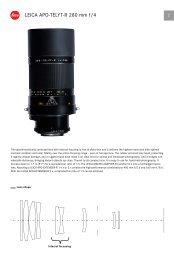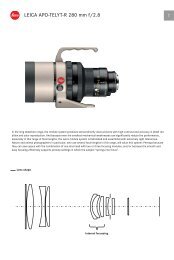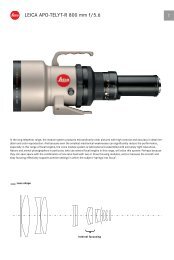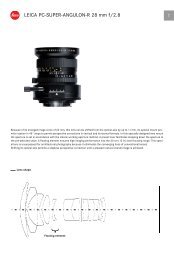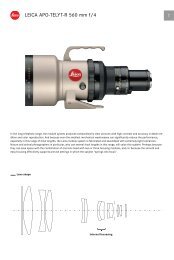Leica M System
Leica M System
Leica M System
You also want an ePaper? Increase the reach of your titles
YUMPU automatically turns print PDFs into web optimized ePapers that Google loves.
LEICA M8 – Outstanding optical performance At <strong>Leica</strong>,<br />
image quality is not just a slogan ; it is achieved by optimizing every link<br />
in the performance chain. The high-speed <strong>Leica</strong> M lenses with 6 bitdesign<br />
actually offer a slight improvement in performance, while the<br />
modified sensor, the use of digital negative format (DNG) and the<br />
Capture One LE RAW data converter ensure the best possible image<br />
quality.<br />
M lenses – 6 bit-coding The lack of a resolution reducing moiré filter in front<br />
of the sensor promotes an exceptionally high linear resolution, which the<br />
modern <strong>Leica</strong> M lenses in particular can deliver. Thanks to their outstanding<br />
resolution capabilities and the high degree of correction, they are perfect for<br />
use with digital technology. The LEICA M8 uses an optical scanner on the<br />
camera’s bayonet to identify the 6 bit-coding of the current <strong>Leica</strong> M lenses.<br />
This allows the slight vignetting caused by the system to be compensated,<br />
further improving the familiar high image quality. The lens type identified is<br />
saved in the EXIF data for the image file and the reflector position on modern<br />
flash units is adjusted to the image angle depending on the focal length.<br />
Typical <strong>Leica</strong> : Existing M lenses can be retroactively 6 bit-coded by our<br />
Customer Service department.<br />
Modified Sensor CCD technology provides the lowest level of image noise and<br />
was therefore chosen for the image sensor in the M8. A high basic speed of ISO 160<br />
extending to a maximum speed setting of ISO 2500 produces pictures with far<br />
richer detail than analog films can deliver. A moiré filter, which optically filters out<br />
fine image details, was deliberately omitted to utilize the full resolution of the<br />
<strong>Leica</strong> M lenses. Instead, any moiré patterns are eliminated by the camera’s signal<br />
processor. Because the light towards the edges impinges on the sensor obliquely<br />
with <strong>Leica</strong> M lenses, the thickness of the cover glass has been reduced to just<br />
0.5 mm to prevent unwanted refraction. As a result, the image has uniform brightness<br />
right to the edge, there is no vignetting caused by the sensor and the existing<br />
<strong>Leica</strong> M lenses can demonstrate their full capabilities on the digital camera. With its<br />
LEICA M8 and LEICA DIGITAL-MODUL-R, <strong>Leica</strong> is the only manufacturer of digital<br />
camera systems to consistently modify existing sensor technology in this way.



